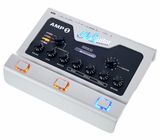Background:
Eight years ago, I laughed at the idea of a nanotube giving a class-D amplifier a tube amp sound and feel. I laughed at Thomas Blug and bought a Marshall DSL-20, Bugera, a Laney Lionheart IRT-60, a tweed style amp and a bunch of modelers instead (e.g. Hotone Ampero, Boss GT-1000, Valeton GP-200, NU-X MG-300). But I was never happy. I already owned a JCM-800 and 900 in the past, a valvestate, Vox amps, Marshall JMP-1 etc. I sold them all (except for the Laney). Eight years later, and after watching dozens of videos, I splurged and bought the AMP1 Mercury. When I got it, an ominous feeling came over me. It was light weight and plastic. When I turned it on, I felt like a Christmas tree had lit up. It looked like a toy. My initial feeling was that I had just blown a stack of money...for what...a toy?! To my utter surprise, and after some tweaking, the amp does indeed sound like a Plexi, a JCM800, a Fender-ish tweed and an unidentified modern, high gain tube amp. I kept on thinking that this can't be. I had to constantly do a reality check. At this point, I'd like to apologise to Thomas Blug for doubting his product. I haven't had so much fun with an amp since I first plugged my Strat into a JCM-800 as a teenager.
Yes, it sounds like a Marshall:
I fiddled with the tone knob to get the amp to sound exactly like my JCM800 - cranked. And it did. After figuring out how to use a midi pedal to turn the power soak and effects loop on, it sounds even more like my 80's Marshall rig but better. I can't stop sneaking into my studio for a play. It just sounds great.
Compared to modelers:
With my modelers, my guitars all sounded more or less the same: dead, no dynamics, razor-fuzz-sound. With the Amp1, my Strat sounds like a Strat and my LP sounds like an LP. I hadn't done a scratch-down in decades. A scratch down on my modeler sounds s**t. On the Amp1, you can hear all the nuances immediately as the pick grinds down the strings. When I put the Amp1 through my 2 x 12'' Celestion Greenbacks from the early 70's, the amp roars. It is important to hook up a decent speaker box. Lucky I kept those greenbacks. Even the record-out sounds great into my DAW.
Adjust the settings wisely:
Setting the input levels, gain and the power soak correctly made all the difference. And by the way, all my Marshall amps sounded horrible unless I cranked them up. Even in the late 70's and early 80's, no one could crank a Marshall anywhere unless it was an outdoor gig - and even then, people would complain. At low volume, the big fat Marshall valve amps sounded like an oversized fuzz box. With the Amp1, I can get tube saturation, tube amp dynamics, sagging and overtones at low volume and without the annoying chain saw fuzz of a real Marshall tube amp. Just because an amp has big fat "tubes" and weights 22 Kg doesn't mean it's better.
Also, some people have lamented that the clean channel doesn't sound like a Fender Twin amp or that the crunch channels don't sound Marshall-ish. Marshall used Celestion speakers in their cabinets which contributed strongly to the Marshall sound. Fender used Jensen speakers. They sound completely different to a Celestion. So, if you want to reproduce "the sound", you need to connect the right speaker. Remember, this is not a modeler.
Sound vs playing feel vs acoustic experience:
Any modeler can sound like a Marshall. In a recording, the listener will not hear the difference. The nuances in sound are so small between various modelers and a real Marshall that a listener won't know. However, a modeler vs tube amp will appear to respond differently to the person playing it. A modeler is compressed, flat with few dynamics. A real amp reacts more subtly and with greater dynamics - and so does the Amp1 Mercury. I can pluck a note gently and the Amp1 correctly interprets that. A modeler equalises much of the tone and dynamics. That is why the Amp1 wins. In terms of the player's acoustic experience, a 100 Watt valve amp will violently push the coils in the speaker back and forth so that the speaker box vibrates as air is pushed around. That's the "roar" people talk about when sitting in front of a quad box driven by a Marshall tube amp. Oddly enough, despite being a class-D transistor power amp, the nanotube does help reproduce the "roar" effect fairly accurately. When going into my Music City speaker box, the sound was OK but going into my Marshall greenbacks...boy, that sound is awesome.
Verdict:
I think that Thomas Blug has golden ears and did a great job in designing this unit. There could be improvements but overall, this is not a modeler. This sounds like a tube amp. It's 100% analogue and the nanotube works. That's all there is to it. If I connect a Marshall cab to this amp no one will be able to tell the difference - not the person listening nor the person playing. I'm satisfied and I'm keeping it.


